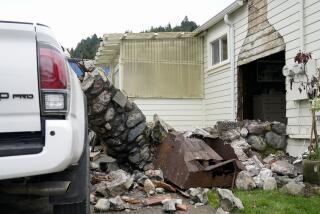St. Helens Generating a Mountain of Activity
- Share via
The numbers of small earthquakes and emissions of carbon dioxide have increased at Mt. St. Helens in Washington state, slightly raising the chances that volcanic steam eruptions last seen in 1991 could resume, scientists report.
The U.S. Geological Survey, in a statement issued last week, said its concern “will be heightened greatly” if the earthquakes move within 1 1/2 miles of the surface of the crater.
After months of small earthquakes, averaging about two a day, the Geological Survey’s William E. Scott, who is stationed at the Cascades Volcano Observatory in Vancouver, Wash., prepared the statement reporting that the number increased to 165 events in May and 318 in June.
Although only 11 quakes measured greater than magnitude 1, and the largest was magnitude 1.8, Scott said two distinct quake clusters were evident directly beneath the lava dome in the crater. One was less than three miles underground and the other four to six miles.
A magnitude 4.1 quake March 20, 1980, signaled the resumption of volcanic activity at Mt. St. Helens after a dormancy lasting 123 years. The mountain began erupting seven days later.
Mt. St. Helens had a major eruption on May 18, 1980, in which the top 1,300 feet of the mountain was blown away and large pyroclastic flows of molten material, as well as mudflows, caused serious flooding nearby. At least 57 people died.
During the climactic eruption, trees nearly 20 miles from the volcano were blown down. Ash falls were recorded hundreds of miles to the north and east.
Eruptions gradually faded in ensuing months and years. But scientists studying prehistoric deposits of volcanic materials have concluded that Mt. St. Helens is one of the most dangerous and frequently erupting volcanoes in the Cascade range. As such, it is subject to frequent scientific monitoring.
In the Geological Survey’s statement, Scott reported: “An airborne survey of volcanic gases revealed the presence of magmatic carbon dioxide.”
He noted that carbon dioxide, which is heavier than other atmospheric gases, can collect in ground depressions and possibly threaten hikers, campers and skiers with asphyxiation.
The carbon dioxide is believed to be escaping from magma, or lava, which has risen again to within about four miles of the crater floor, Scott said.
However, he added, there has been no ground deformation recorded in the area, a sign that whatever activity there is is limited.
The Geological Survey said its monitoring will continue and reports will be made of any signs of geological change.
More to Read
Sign up for Essential California
The most important California stories and recommendations in your inbox every morning.
You may occasionally receive promotional content from the Los Angeles Times.










